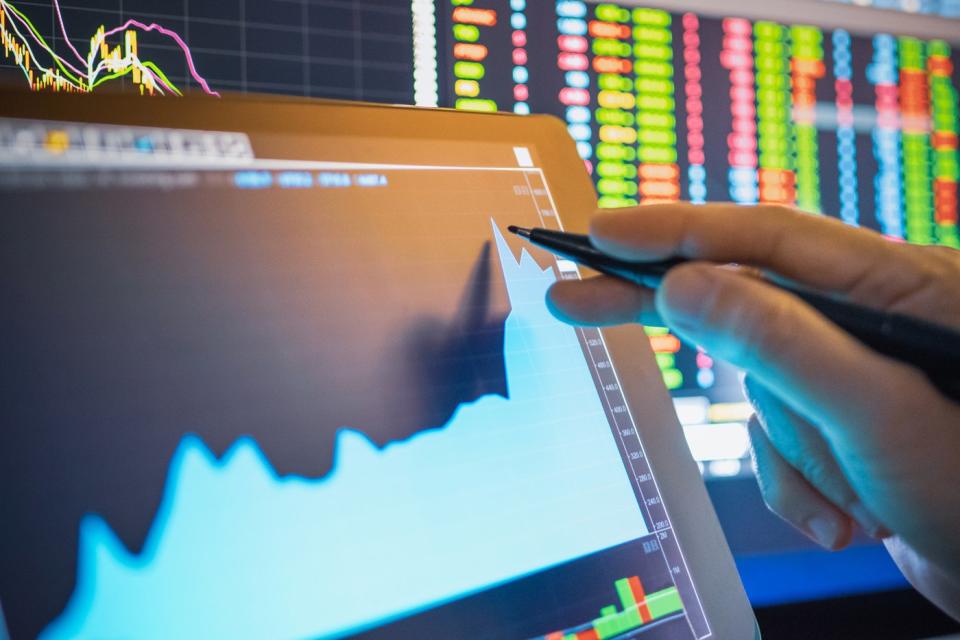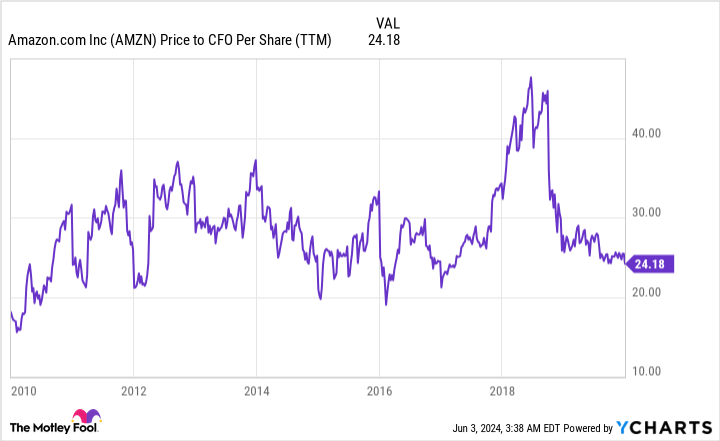Over the long run, the stock market has proved to be a superior wealth creator. Over the last century, no other asset class has come anywhere close to matching the annualized average return generated by stocks.
But not all stocks are created equally.
One of Wall Street’s greatest attributes is that it’s dynamic. History tells us that today’s largest stocks are unlikely to be the biggest publicly traded companies 20 years from now. Ongoing innovation, mergers, acquisitions, legal judgments, competition, and a host of other factors are constantly shaking up the “leaderboard” on Wall Street.
Despite this unpredictability, I strongly believe one of the largest companies on today’s leaderboard can overcome historic odds and become the first stock to reach a $5 trillion market cap.

It won’t be these three widely touted “Magnificent Seven” stocks
For a company to reach a $5 trillion valuation, it would have to be an industry leader that’s fueled by innovation and generates boatloads of cash flow. In other words, the perfect definition of companies found in the “Magnificent Seven.” However, some of the most-logical candidates among the Magnificent Seven are the stocks I believe are least likely to reach the psychological $5 trillion level.
For example, the infrastructure backbone of the artificial intelligence (AI) movement, Nvidia (NASDAQ: NVDA), probably looks like a no-brainer to become the world’s largest company by market cap. Nvidia’s graphics processing units (GPUs) have become the standard in high-compute data centers, which has afforded the company exceptional pricing power.
On the other hand, investors have, without fail, overestimated the adoption of every next-big-thing innovation or new technology for 30 years. Although AI is the hottest thing on Wall Street, most businesses aren’t even sure how to utilize the technology to drive additional sales and profits. It’s going to take time for AI utility to evolve, which likely means an AI bubble-bursting event is coming at some point in the future.
I’ll also add that Nvidia’s top four customers, which comprise about 40% of its net sales, are all developing GPUs for their AI-accelerated data centers. Even if these chips are used in just a complementary fashion to Nvidia’s GPUs, it likely signals a peak in order activity.
I wouldn’t count on Apple (NASDAQ: AAPL) being the first $5 trillion stock, either. Though Apple’s iPhone dominates in the domestic smartphone market, and the company has repurchased a truly jaw-dropping $674 billion worth of its common stock since initiating a buyback program in 2013, its growth engine has completely stalled.
Last year, every physical product segment for Apple saw sales decline. Some of this decline can be attributed to the COVID-19 pandemic. For instance, personal computer sales are retracing now that workers have returned to the office. But continued weakness in iPhone sales suggests that recent innovations aren’t hitting home with consumers.
Electric-vehicle (EV) maker Tesla (NASDAQ: TSLA) is unlikely to be the first $5 trillion stock, as well. Despite being North America’s leading EV manufacturer and the only pure-play EV company to generate a recurring profit, Tesla’s growth engine has sputtered and its efforts to become more than a car company have predominantly fallen flat.
Growing competition in the EV arena has encouraged Tesla to slash its prices on more than a half-dozen occasions since the start of 2023. These price cuts have reduced Tesla’s operating margin from 17.2% to just 5.5%. With EV inventory levels still rising, additional margin-crushing price cuts may be necessary.
Furthermore, CEO Elon Musk has given investors few reasons to cheer. Though he’s overseen the introduction of five mass-produced models (3, S, X, Y, and Cybertruck), the overwhelming majority of Musk’s promised innovations haven’t been fulfilled. If these promises are backed out of Tesla’s valuation, the company looks anything but “magnificent.”


Wall Street’s first $5 trillion stock will be…
Among the handful of companies that have helped push the Dow Jones Industrial Average, S&P 500, and Nasdaq Composite to record highs, it’s e-commerce colossus Amazon (NASDAQ: AMZN) that has the best chance to be Wall Street’s first $5 trillion stock.
While Amazon’s e-commerce marketplace is the face of the company, online retail sales produce razor-thin margins and are minimally relevant when it comes to generating operating cash flow and net income. It’s Amazon’s three faster-growing and higher-margin ancillary operating segments that give it the ability to become Wall Street’s largest publicly traded company.
It all starts with Amazon Web Services (AWS), which is the world’s leading cloud infrastructure service platform. Even though businesses are still in the relatively early stages of ramping up their cloud-service spending, AWS surpassed $100 billion in annual run-rate sales, as of the March-ended quarter. This is a considerably higher-margin segment than e-commerce, and it’ll consistently grow at a much faster pace. As a stand-alone business, I believe AWS could be worth up to $3 trillion by the end of the decade, based on its current growth trajectory.
The second all-important operating segment that can help carry Amazon to a $5 trillion valuation is subscription services. Before stepping down as CEO, Jeff Bezos announced in April 2021 that his company had leaped above 200 million global Prime subscribers. The steady growth of its online marketplace, along with securing the exclusive streaming rights to Thursday Night Football, gives Amazon strong pricing power with Prime.
The third puzzle piece is its advertising segment. Amazon is attracting in the ballpark of 2.5 billion unique visitors to its website on a monthly basis. Since of most of these visitors are motivated shoppers, Amazon has an insatiable dangling carrot that encourages advertisers to pay a premium to get their message(s) in front of shoppers.
Collectively, these three segments are what generate almost all of Amazon’s operating cash flow.
While earnings per share (EPS) is a smart measure of value for mature businesses, Amazon tends to reinvest a majority of its cash flow into high-growth initiatives. Though this can, at times, have a negative impact on its EPS, these aggressive investments are rapidly increasing its cash flow — and cash flow is a far better measure of value for Amazon.
During the entirety of the 2010s, Amazon closed out each year at a multiple of 23 to 37 times forward-year cash flow. Put another way, investors willingly paid a median of 30 times operating cash flow to own shares of Amazon during the prior decade.
By 2027, Wall Street’s consensus calls for $18.64 in cash flow per share. Based on where Amazon closed on Friday, May 31, this would place it at a multiple of just 9.5 times cash flow. If Amazon were to sustain a 10% annualized growth rate in cash flow through 2030 (based on the $18.64-per-share consensus for 2027), its multiple would drop to just 7.
Amazon’s stock can comfortably rise by the 172% needed to reach a $5 trillion valuation and still come in well below its median cash flow multiple from the previous decade. Among Wall Street’s most-influential businesses, it has the clearest path to an eventual $5 trillion market cap.
Should you invest $1,000 in Amazon right now?
Before you buy stock in Amazon, consider this:
The Motley Fool Stock Advisor analyst team just identified what they believe are the 10 best stocks for investors to buy now… and Amazon wasn’t one of them. The 10 stocks that made the cut could produce monster returns in the coming years.
Consider when Nvidia made this list on April 15, 2005… if you invested $1,000 at the time of our recommendation, you’d have $713,416!*
Stock Advisor provides investors with an easy-to-follow blueprint for success, including guidance on building a portfolio, regular updates from analysts, and two new stock picks each month. The Stock Advisor service has more than quadrupled the return of S&P 500 since 2002*.
*Stock Advisor returns as of June 3, 2024
John Mackey, former CEO of Whole Foods Market, an Amazon subsidiary, is a member of The Motley Fool’s board of directors. Sean Williams has positions in Amazon. The Motley Fool has positions in and recommends Amazon, Apple, Nvidia, and Tesla. The Motley Fool has a disclosure policy.
Prediction: This Will Be Wall Street’s First $5 Trillion Stock was originally published by The Motley Fool
Source Agencies


